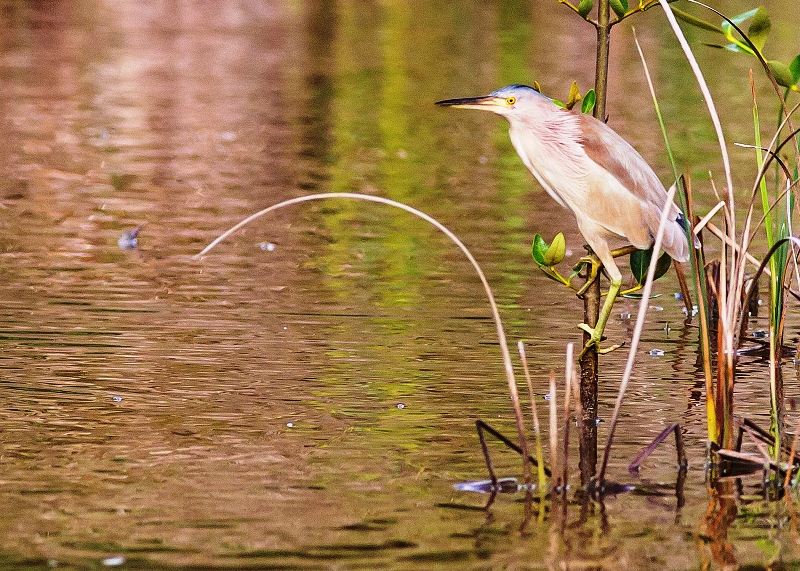The next extinction in Seychelles? |09 February 2015

A tragedy is looming large in Seychelles but it has received little or no attention. If you ask most people ‘What is the most endangered native bird of Seychelles’ perhaps they might say ‘magpie robin (pisantez), paradise flycatcher (Vev) or black parrot (katonwar)’. It is none of these; it is almost certainly the yellow bittern (makakzonn in Creole).
Despite the name, the yellow bittern is not really yellow at all, more a pale buff, similar to the dry reeds in which it is found. Its cryptic camouflage means it usually remains unseen when approached. At the last moment it takes flight, giving a harsh kakkak call and revealing striking jet black flight feathers contrasting sharply with an otherwise pale plumage. What makes the Seychelles population so special is that it is the only one in the entire African region. In the dim and distant past long before the arrival of humans, these birds invaded Seychelles from Asia and made the country their most westerly outpost. Their presence is a living reminder of the ancient land bridge that once joined two mighty continents, with Seychelles at the epicentre.
At the time of the first French settlement there were probably several thousand yellow bitterns in the abundant marshes of the coastal plateaus. Gradually, the marshes on which they depended were drained, converted to farmland or built upon. Inevitably numbers declined but there was still no imminent danger of extinction. In 2002, I co-authored a study that estimated the population at about 228, with birds present at six marshes on Mahé, one on Praslin and one at La Digue. Since then, most of these sites have been reduced in size and some of them virtually destroyed, including North East Point, Beau Vallon, Amitié and much of the La Digue plateau. Only Roche Caiman, Cap Ternay and Police Bay have remained intact but the sword of Damocles hovers over two of these. It seems unlikely there are more than 100 birds left in total, perhaps fewer. Further destruction of wetlands may soon tip the population over the edge so that it is no longer sustainable.
Why has there been no outcry? The problem for the poor old bittern is that it is not considered endemic because it also occurs in Asia. No one has done a DNA study to confirm this fact, but measurements differ somewhat from Asian birds so perhaps it is endemic, at least at the level of subspecies? There is a heavy emphasis by conservation bodies on the importance of endemics and this is perhaps sometimes to the detriment of other threatened native species.
The focus on endemic birds is understandable and has resulted in some great conservation successes. Translocations and protection measures have reversed the decline of most endemic species so that today, not a single species is likely to be lost, at least in the foreseeable future. This is great news. However, sometimes it seems that if a bird is not endemic it is not considered important. In the case of the bitterns this is clearly wrong; they belong in Seychelles and are a unique feature of the country’s bird life and its Asian heritage.
Ignoring non-endemic native birds also ignores habitat. In Seychelles there has been a massive loss of their wetland habitat. Wetlands are vitally important. They prevent flooding by holding water like a sponge. They sieve and purify the surface water, so that like the human kidney, they filter, cleanse and rejuvenate the ecosystem. They provide habitats for fish, frogs, terrapins, tortoises, aquatic birds and plants.
Another problem for bitterns is the scale of tourism development in Seychelles. Tourism is the life blood of the economy but sadly, hotel developments on the coastal plateau have rarely made concessions to the bitterns or their wetland habitat. There are one or two exceptions, notably Roche Caiman and the wetland at Kempinski Resort. The latter is probably now the best place on Mahé to see bitterns, though even here a road has been built across one side of the wetland, reducing the habitat and creating disturbance (but thankfully to a limited extent). A beautiful wetland at nearby Four Seasons also has the potential to attract bitterns if reeds are planted to give the birds cover and nesting sites. As for Police Bay, it is perhaps not too late to weigh up the value of a marina full of expensive yachts versus a wetland full of wildlife. Also, if old wetlands have gone forever perhaps new artificial wetlands similar to Roche Caiman could be created as havens for wildlife?
Meanwhile, the pressure continues. In 2014, a Yellow Bittern arrived at Desroches, the first record for the outer islands. But on an island with no wetland it starved to death. Is it a coincidence that its arrival coincided with building construction on the former Beau Vallon marsh? Perhaps a bird whose habitat was destroyed was forced across the ocean? We can never know and likewise we may wake up one day and find the last bittern has gone over the horizon and we don’t know how it happened. This would be a tragic loss.
The nature of Seychelles is the country’s greatest asset and ecotourism can provide benefits for both people and wildlife. Yellow bitterns are a fascinating and unique part of the Seychelles environment. It is not too late to save the yellow bittern but the clock is ticking very fast.
Adrian Skerrett




